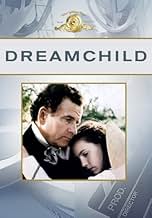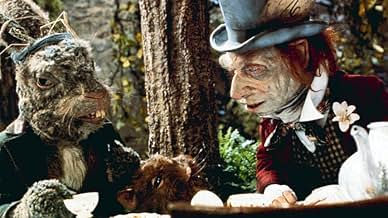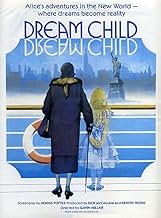VALUTAZIONE IMDb
6,6/10
1826
LA TUA VALUTAZIONE
Aggiungi una trama nella tua linguaIan Holm is children's author Lewis Carroll in this poignant fantasy-drama set in 1930s New York and populated by the fabulous special effects creatures of Muppet master Jim Henson.Ian Holm is children's author Lewis Carroll in this poignant fantasy-drama set in 1930s New York and populated by the fabulous special effects creatures of Muppet master Jim Henson.Ian Holm is children's author Lewis Carroll in this poignant fantasy-drama set in 1930s New York and populated by the fabulous special effects creatures of Muppet master Jim Henson.
- Regia
- Sceneggiatura
- Star
- Nominato ai 2 BAFTA Award
- 7 vittorie e 6 candidature totali
Trama
Lo sapevi?
- QuizBecause its American theatrical release was limited, and she was extremely proud of this movie, Coral Browne went on a self-funded promotional tour.
- BlooperDuring the tea dance Jack and Lucy waltz to "I Only Have Eyes For You." The scene is set in 1932, but the song was not written until 1934.
- Citazioni
Alice Hargreaves: That's quite intolerable. It would be difficult enough at my age to be what I once was, but utterly impossible to be what I never was.
- ConnessioniFeatured in At the Movies: The Trip to Beautiful/Ran/Clue/Dreamchild (1985)
- Colonne sonoreAll of Me
(uncredited)
Music by Gerald Marks
Lyrics by Seymour Simons
Performed by a vocalist with the ship's band
Recensione in evidenza
Let me start by simply saying that the reaction I had viewing this film was unlike any other viewing experience I can recall. Although I found it well written and produced, I was so disappointed by the 2/3's point that I almost stopped watching. Yet by the end I was absolutely embracing the whole thing. So if you are a Lewis Carroll fan keep an open mind and watch the whole thing, you may find the whole much greater than the sum of its parts. And you may even find yourself willing to accept the historical fiction as necessary to better tell the story.
I suppose a large part of my initial negative reaction was due to the film's puzzling failure to capture a fundamental aspect of Alice Liddell's childhood personality. Alice spent much of her time in "Wonderland" being p .d off; at the illogic, the rudeness, and the selfishness of the characters she met there. Both Alice's were proper and confident little Victorian girls who took themselves very seriously. I am sure that this was one of many "Real Alice" personality traits that Carroll transplanted to his "Wonderland" Alice. Often amused by her reactions of irritation and frustration, he constructed many of the story elements with the intention of getting indigent reactions from Alice and her sisters. I had hoped that this connection would be made by the film and was disappointed that it was not explored, although in retrospect you could argue that the older Alice's reactions to the characters she meets in America are identical to Alice's reactions to the characters in Wonderland. That the film does not explore my pet topic was disappointing but ultimately not fatal.
In all other respects the portrayal of young Alice Liddell was excellent. Amelia Shankley turned in a fine performance. She is clearly the best film Alice so far and it is a shame that they did not star her in an actual Alice film right after "Dreamchild" was completed. And Coral Browne was equally excellent as the older Alice.
This film is about how Alice's mother (who felt her daughter could find much better candidates for marriage as she moved into her teens) essentially poisoned her memories of Dodgson, leading her to believe that there was something wrong about his feelings for her (when in fact he was just a childlike personality who loved her more than his other child friends, but always with a shy innocence). It is also about the guilt the older Alice still feels over abandoning him just as she entered her teens, especially after all the innocent kindness he had shown. She is in denial about her affection for Dodgson and irritated because all the attention of his centennial is forcing her to recall those long-suppressed years of her life. And finally she feels that since she was not actually the little heroine who exhibited so much courage in "Wonderland", she does not deserve her sudden celebrity status. In her view she was catapulted into fame "by simply doing nothing". Remember that Wonderland Alice is arguably the bravest literary heroine of all time.
What ultimately redeems the film is the climatic scene in the hall of Columbia University. Alice Liddell flashes back to a scene late in her relationship with Dodgson, a symbolic scene meant to represent the end of their relationship. She had outgrown him at this point in her life and she laughs and humiliates him as he attempts to sing his Lobster Quadrille song to the three Liddell sisters and their male suitors. When her mind returns to the present she hears the Columbia University orchestra and glee club performing the same song. She realizes that the story which she once rejected was in fact his personal tribute to her and that even after all these years each little detail of his creation is admired throughout the world. At this point she finally gets it. She goes back to the symbolic scene as her older sister Lorina reads the final paragraph from the Wonderland book, the one in which Dodgson reveals the reason he made up the story. Then the child Alice walks over, kisses Dodgson in apology, and places her head on his chest (an omission for which she has long felt guilty). Then we are back in the hall and find that in place of her prepared speech she has read this same passage to the now applauding crowd.
The point is that she finally understood that the story was a gift to her and to future generations of children, that she had inspired the story and had been the model for his heroine. With this realization came the final gift of knowing that the virtues Mr. Dodgson gave his heroine: innocence, courage, curiosity, wonder, kindness, intelligence, courtesy, humor, dignity, and a sense of justice; were virtues he credited to the real Alice.
It is hard to imagine a better scene (or sequence of scenes) than the climatic one detailed above. Film and video cannot hope to compete with books in communicating thoughts. But with the right players film can visually communicate moments of character realization and transformation to a degree much more subtle and personal than what any author can write. This is the real magic of film and acting for the camera. In the end these climatic moments say everything that needs be said about the relationship between Dodgson and his "dreamchild". A truly great cinematic moment and my all-time favorite.
I suppose a large part of my initial negative reaction was due to the film's puzzling failure to capture a fundamental aspect of Alice Liddell's childhood personality. Alice spent much of her time in "Wonderland" being p .d off; at the illogic, the rudeness, and the selfishness of the characters she met there. Both Alice's were proper and confident little Victorian girls who took themselves very seriously. I am sure that this was one of many "Real Alice" personality traits that Carroll transplanted to his "Wonderland" Alice. Often amused by her reactions of irritation and frustration, he constructed many of the story elements with the intention of getting indigent reactions from Alice and her sisters. I had hoped that this connection would be made by the film and was disappointed that it was not explored, although in retrospect you could argue that the older Alice's reactions to the characters she meets in America are identical to Alice's reactions to the characters in Wonderland. That the film does not explore my pet topic was disappointing but ultimately not fatal.
In all other respects the portrayal of young Alice Liddell was excellent. Amelia Shankley turned in a fine performance. She is clearly the best film Alice so far and it is a shame that they did not star her in an actual Alice film right after "Dreamchild" was completed. And Coral Browne was equally excellent as the older Alice.
This film is about how Alice's mother (who felt her daughter could find much better candidates for marriage as she moved into her teens) essentially poisoned her memories of Dodgson, leading her to believe that there was something wrong about his feelings for her (when in fact he was just a childlike personality who loved her more than his other child friends, but always with a shy innocence). It is also about the guilt the older Alice still feels over abandoning him just as she entered her teens, especially after all the innocent kindness he had shown. She is in denial about her affection for Dodgson and irritated because all the attention of his centennial is forcing her to recall those long-suppressed years of her life. And finally she feels that since she was not actually the little heroine who exhibited so much courage in "Wonderland", she does not deserve her sudden celebrity status. In her view she was catapulted into fame "by simply doing nothing". Remember that Wonderland Alice is arguably the bravest literary heroine of all time.
What ultimately redeems the film is the climatic scene in the hall of Columbia University. Alice Liddell flashes back to a scene late in her relationship with Dodgson, a symbolic scene meant to represent the end of their relationship. She had outgrown him at this point in her life and she laughs and humiliates him as he attempts to sing his Lobster Quadrille song to the three Liddell sisters and their male suitors. When her mind returns to the present she hears the Columbia University orchestra and glee club performing the same song. She realizes that the story which she once rejected was in fact his personal tribute to her and that even after all these years each little detail of his creation is admired throughout the world. At this point she finally gets it. She goes back to the symbolic scene as her older sister Lorina reads the final paragraph from the Wonderland book, the one in which Dodgson reveals the reason he made up the story. Then the child Alice walks over, kisses Dodgson in apology, and places her head on his chest (an omission for which she has long felt guilty). Then we are back in the hall and find that in place of her prepared speech she has read this same passage to the now applauding crowd.
The point is that she finally understood that the story was a gift to her and to future generations of children, that she had inspired the story and had been the model for his heroine. With this realization came the final gift of knowing that the virtues Mr. Dodgson gave his heroine: innocence, courage, curiosity, wonder, kindness, intelligence, courtesy, humor, dignity, and a sense of justice; were virtues he credited to the real Alice.
It is hard to imagine a better scene (or sequence of scenes) than the climatic one detailed above. Film and video cannot hope to compete with books in communicating thoughts. But with the right players film can visually communicate moments of character realization and transformation to a degree much more subtle and personal than what any author can write. This is the real magic of film and acting for the camera. In the end these climatic moments say everything that needs be said about the relationship between Dodgson and his "dreamchild". A truly great cinematic moment and my all-time favorite.
- aimless-46
- 14 dic 2004
- Permalink
I più visti
Accedi per valutare e creare un elenco di titoli salvati per ottenere consigli personalizzati
- How long is Dreamchild?Powered by Alexa
Dettagli
- Data di uscita
- Paese di origine
- Lingua
- Celebre anche come
- Das wahre Leben der Alice im Wunderland
- Luoghi delle riprese
- Aziende produttrici
- Vedi altri crediti dell’azienda su IMDbPro
Botteghino
- Budget
- 4.000.000 £ (previsto)
- Lordo Stati Uniti e Canada
- 1.215.923 USD
- Fine settimana di apertura Stati Uniti e Canada
- 5.425 USD
- 6 ott 1985
- Lordo in tutto il mondo
- 1.215.923 USD
Contribuisci a questa pagina
Suggerisci una modifica o aggiungi i contenuti mancanti

Divario superiore
By what name was Dreamchild (1985) officially released in India in English?
Rispondi

































